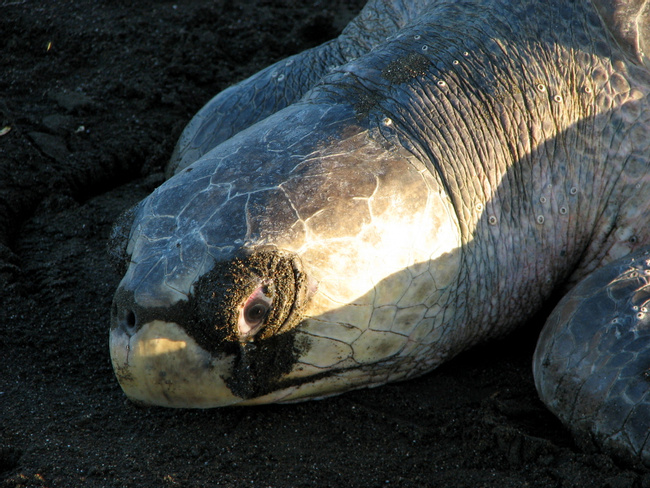Olive Ridley Sea Turtle
Olive Ridley (Lepidochelys olivacea) Spanish Name: Tortuga lora

More about Olive Ridley Sea Turtle
Habitat
The olive ridley swims among the warm waters of the tropics.
Physical Description
Its wide carapace (or shell) is heart-shaped and has 6 to 8 scutes (or plates) on each side of the center row. Two pairs of scales are on the face between the eyes and nostrils. On its upper sides the turtle is mostly an olive green color, with greenish-white on the undersides. Males have a long tail and a concave plastron (the belly side of the shell), while females have a short tail and a flat plastron.
Biology and Natural History
The olive ridley displays a spectacular behavior known as an arribada, which is a vast group of turtles collecting to nest at the same time and place, and it occur in five beaches in the world. Only one other species, the critically endangered Kemp's ridley (Lepidochelys kempi) holds these arribadas of synchronized nesting. Olive ridley arribadas peak in September or October. In the off season, small arribadas of 500 to 10,000 females may congregate between January and June.
The arribada begins and ends abruptly. More than 150,000 sea turtles congregate offshore in shallow waters. Once the females begin moving towards the shore in droves, they do not stop, continuing through daybreak or disturbance. If the weather is extremely bad, they may delay for a time and retain their eggs until the sky clears. The arribada lasts four to eight days, bringing waves of turtles up the beach at each high tide.
With so many turtles nesting in a small area, a lot of eggs are dug up or destroyed by the females who arrive later in the arribada. In some countries its legislation allows some egg harvesting at the beginning of the arribada to use the eggs that would otherwise be crushed.
Although the turtle is protected by international law, the olive ridley is still suffering many deaths and the magnificent arribadas are getting smaller. Trawling and fishing during a single arribada can cause devastating losses for this sensitive species. The effects of such damage last a long time.
The olive ridley is a vulnerable species. It is protected by international policies and illegal to hunt. Read about Sea Turtles: Promises and Threats to learn more about the challenges facing this animal.
Diet
Some of the important food groups for the olive ridley are fish, crabs, jellyfish, and mollusks.
Height/Weight
This sea turtle is small compared to its relatives. The carapace (or shell) is usually between 60 and 70 cm long. An adult female can weigh just over 40 kg.
Taxonomy
Order: Testudines
Family: Cheloniidae
Sources
Cornelius, S. E., in: Janzen, Daniel H. Costa Rican Natural History. Chicago: University of Chicago Press, 1983.
Leenders, Twan. A Guide to Amphibians and Reptiles of Costa Rica. Zona Tropical, S.A, Miami, FL, 2001.
Amy Strieter, Wildlife Writer
Similar Profiles
It's more than just having a good time or visiting beautiful places (although that's absolutely a part of it!), it's about being part of a unique experience that stays with you.



